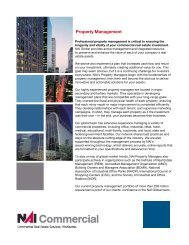2010 Global Market Report - NAI Commercial Real Estate
2010 Global Market Report - NAI Commercial Real Estate
2010 Global Market Report - NAI Commercial Real Estate
- No tags were found...
Create successful ePaper yourself
Turn your PDF publications into a flip-book with our unique Google optimized e-Paper software.
MalaysiaWith Malaysia’s dependence on exports and FDI, the impact of the global recessionhas been severe. Projections for GDP growth in 2009 and <strong>2010</strong> are -3.6% and 2.5%,respectively. Estimates for consumer price increases in 2009 and <strong>2010</strong> are -2.2% and2.2%, respectively.Tourism is one of the country's biggest revenue sources, accounting for 12-13% ofgross domestic product. State investment agency Khazanah Nasional plans to investover RM1 billion in the leisure industry over the next two to three years in leisureprojects. Over the next few years, Malaysia will have some RM2.5 billion worth of newtourism attractions (including Nujasaya, Legoland and Kidzania) which are expected toattract nearly 2 million visitors combined annually.New ZealandThe global recession has greatly impacted New Zealand and its commercial propertymarkets. Projections for GDP growth in 2009 and <strong>2010</strong> are -2.2% and 2.2%, respectively.Estimates for consumer price increases in 2009 and <strong>2010</strong> are 1.5% and 1%,respectively.<strong>Commercial</strong> landlords continue to struggle with declining values, lower rents andincreasing incentive packages. Office and industrial vacancies continue to climb.While the residential market in New Zealand has come back with significant strength,the global markets to need to correct further before similar results in the commercialsector occur.SingaporeThe global recession has been felt strongly in Singapore, as it is highly trade-dependent.Projections for GDP growth in 2009 and <strong>2010</strong> are -3.3% and 4.1%, respectively.Estimates for consumer price increases in 2009 and <strong>2010</strong> are -0.2% and 1.6%,respectively.Defying all expectations, Singapore's residential property market has rebounded in thethick of the nation’s worst recession. New home sales between January and August of2009 were already 80% of the total homes sold for the whole of 2007. But goingforward, prices of mass market and mid-tier projects will face resistance. The governmenthas announced anti-speculation measures to moderate sales volume and prices:immediate removal of the interest absorption scheme (IAS) and the interest-onlyhousing loans (IOL) scheme for projects yet to be launched.In the office market, Singapore recorded positive take-up in the third quarter of 2009after three quarters of negative take-up. The island-wide vacancy rate for Class A officespace increased from 10.8% in the second quarter of 2009 to 12.2% in the thirdquarter, a trend that is expected to continue as supply comes online.The emphasis for retailers has shifted from store openings to streamlining operations,prompting a 14.4% fall in rents over the year through June 2009. Rents in the OrchardRoad area will remain under pressure due to the large volume of new supply in the next12-18 months.<strong>2010</strong> <strong>Global</strong> <strong>Market</strong> <strong>Report</strong> ■ www.naiglobal.com19





